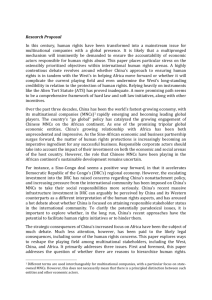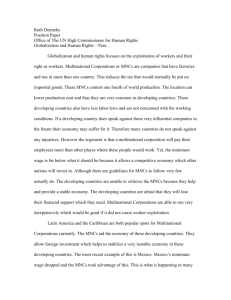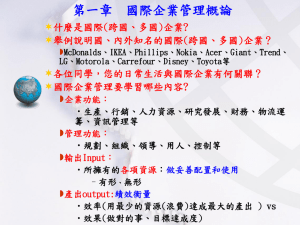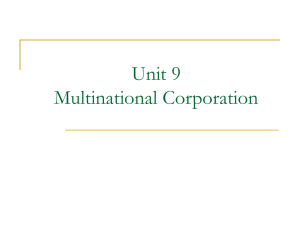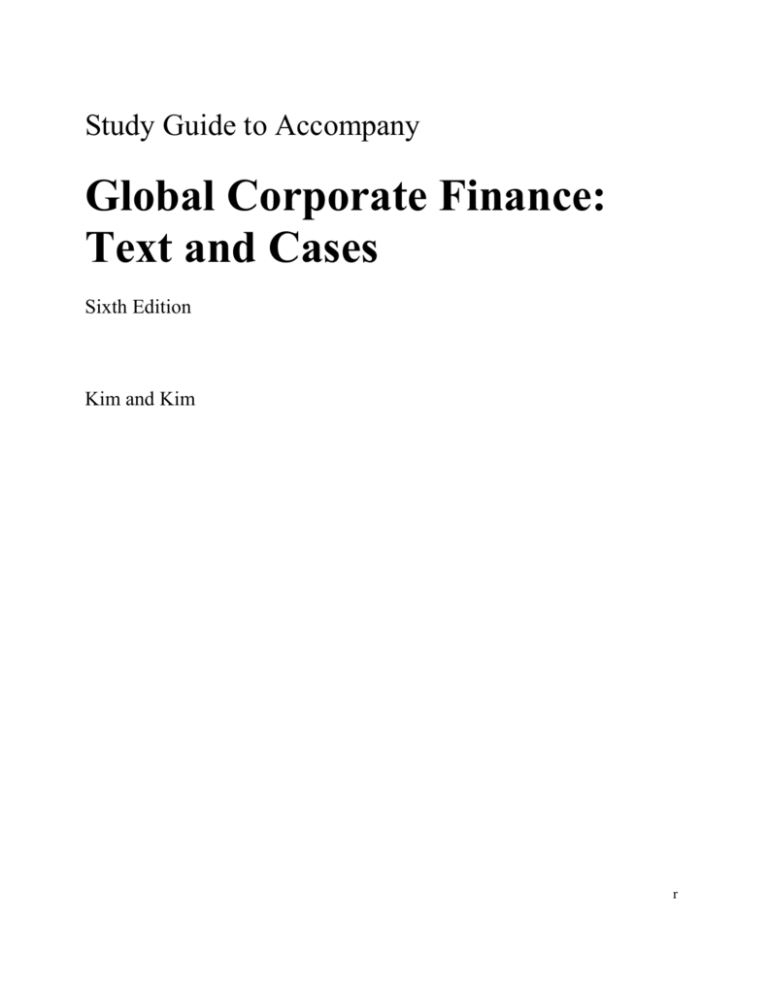
Study Guide to Accompany
Global Corporate Finance:
Text and Cases
Sixth Edition
Kim and Kim
r
Copyright © Dan Baack and Stacey Banks, 2006.
First published 2006
All rights reserved. Instructors using Global Corporate Finance: Text and Cases, Sixth Edition,
by Kim and Kim may reproduce materials for classroom use. Otherwise, no part of this disk may
be reproduced, stored in a retrieval system, or transmitted, in any form or by any means,
electronic, mechanical, photocopying, recording, or otherwise, without the prior written
permission of the publishers.
Blackwell Publishers Inc.
350 Main Street
Malden, MA 02148
USA
Blackwell Publishers Ltd
108 Cowley Road
Oxford, OX4 1JF
UK
r
Preface
This study guide is an integral part of the Global Corporate Finance: Text and cases learning
package. Each chapter of this guide includes:
a listing of chapter objectives
to provide a set of guidelines as students begin to study a new chapter
a chapter outline
to guide each step of the study of the chapter
a listing of key terms and concepts with definitions
to provide a brief overview of the essential points of the chapter
multiple choice questions
to build confidence by giving questions that are similar to (but not the same as)
those in the test bank
review problems with solutions for key chapters
to offer additional practice in the techniques and tools of analysis presented in
the chapter.
Together, these different elements allow students the opportunity to review for examinations, to
hone their problem solving skills, to ensure a through coverage of the key topics of the chapter,
and a way to structure their studying by using the chapter outline.
In addition, this study guide contains two useful items: Internet exercises and currency codes
and symbols. The Internet exercises are designed to help visitors use our website more
effectively. Currency codes and symbols include the list of most currencies, their three-letter
codes, and their traditional symbols.
Dan Baack
Stacey Banks
r
Contents
CONTENTS
1.
2.
3.
4.
5.
6.
7.
8.
9.
10.
11.
12.
13.
14.
15.
16.
17.
18.
19.
20.
Introduction ………………………………….………………………... 1
Motives for World Trade and Foreign Investment ….………………… 13
The Balance of Payments …………………………….……………….. 29
The International Monetary System ………………….…………….…. 41
The Foreign Exchange Market and Parity Conditions….……………… 58
Currency Futures and Options ….……………………….…………….. 73
Financial Swaps .………………………………………….…………... 86
Exchange Rate Forecasting ….…………………………….………….. 97
Managing Transaction Exposure and Economic Exposure….……….…110
Translation Exposure Management .……………………….…………...122
International Financial Markets ………………………....….…………..133
International Banking Issues and Country Risk Analysis ………………152
Financing Foreign Trade ……...………………………………….…..…167
Financing Foreign Investment ………………….……………….……...183
International Working Capital Management ….………………….……..201
International Portfolio Investment ………………….…………….……..217
Corporate Strategy and Foreign Direct Investment ……………….…….231
International Capital Budgeting Decisions ...……..……………………..244
The Cost of Capital for Foreign Projects .……………………………….265
Corporate Performance of Foreign Operations ………………………….279.
r
1
Introduction
1
Introduction
Chapter Objectives
1.
To explain three major reasons to study international finance.
2.
To identify the primary goal of a multinational company and the functions of the
financial manager necessary to achieve this primary goal.
3.
To define a multinational corporation and classify the types of multinational
corporation.
4.
To discuss the major principles of global finance which have enabled MNCs to
perform better than their domestic counterparts.
5.
To explain agency theory and corporate governance that deal with the conflict of
interest between managers and stockholder.
6.
To describe major environmental constraints that impede an MNC's effort to
achieve its goal.
Chapter Outline
I.
There are many reasons for business students to study international finance.
A. By studying international finance, students will develop a better
understanding of the current global business environment. The three
following changes have fundamentally transformed this environment.
i. The Cold war ended in 1989 when the Soviet Union relaxed its
control over Eastern European countries and then followed suit
two years later. All of these countries have rejected the basic
tenants of Communism and are now undergoing a rapid and
sometimes painful transition to a more capitalist system.
ii. Many countries in many different parts of the world have also seen
incredibly rapid industrialization and high rates of economic
1
II.
growth in the last thirty years. These emerging markets are mainly
located in East Asia and Latin America.
iii. The integration of national economies, mainly through increased
globalization, has increased the importance of international
operations. A “death of distance” has occurred as technological
improvements remove barriers to communication and lower
transportation costs. Additionally, trade barriers have been
removed thereby decreasing blockades to foreign direct
investment.
B. International finance is increasingly important for all businesses.
i. Each nation is economically related to other nations through a
complex network of international trade, foreign investment, and
international loans.
ii. Most large and medium sized companies around the world have
international business operations.
iii. International events, including international financial activities,
affect all businesses, even those without foreign operations.
C. Knowledge of international financial activities, such as trade and
investments flows between nations, go beyond occupation concerns and
are an important foundation of being an informed individual. For
example, knowledge of international finance may help students when
searching for employment.
MNCs have a variety of goals and these goals drive the functions of their
financial managers.
A. One of the goals of MNCs is to effectively set priorities and deal with
conflicts between suppliers, stockholders, customers, creditors,
employees, and the local community. The maximization of stockholder
wealth is the usual objective of a MNC.
B. The three roles of financial managers are financial planning and control,
the allocation of funds, and the acquisition of funds. In recent years, the
role of the financial manager has begun expanding.
i. Financial control and planning mainly involves the preparation of
budgets (a type of established standard), a planning function, and
the administration of these budgets, a controlling function. The
foreign exchange market and international accounting play a key
role in this process. The cornerstone of effective control and
planning is meaningful financial reports.
ii. Each dollar invested has alternative uses. A financial manager
plans for the allocation of these funds, especially the wise
investment of funds within the firms. For international firms, there
are more opportunities for investment but there is a corresponding
increase in risk, both of which should be considered by financial
managers.
iii. A critical role for financial managers is to determine the
combination of methods to acquire funds that best meets the stated
needs of the firm. This requires balancing low cost and the risk of
2
III.
not being able to pay bills. There are three methods for financial
managers of MNCs to acquire funds on more positive terms –
picking instruments, picking countries, and picking currencies.
iv. The role of the financial manager has expanded to include
increased concern with financial strategy. This change is driven by
the globalization of competition and the integration of world
financial markets, thereby increasing the important of international
finance.
There are many possible definitions of “multinational corporation,” and an
examination of economic indicators shows that American MNCs perform
better than their purely domestic counterparts.
A. There are approximately 60,000 multination companies in the world with
500,000 foreign affiliates and they account for around 25% of world
output. In the 21st century, MNCs are expected to play an even greater
role.
B. “A business organization that produces a product, sells a product, and
provides a service in two or more countries” is the definition of
multinational corporation found in The World Book Encyclopedia.
C. The U.S. Department of Commerce defines an American MNC as “the
U.S. parent and all of its foreign affiliates.”
i. A U.S. parent is a person, residing in the U.S., who owns or
controls a minimum of 10% voting equity in a foreign firm.
ii. A person is any individual, branch, partnership, associated group,
association, estate, trust, corporation, other organization, or any
government entity.
iii. A foreign affiliate is a foreign business enterprise in which a U.S.
person owns or controls a minimum of 10% voting equity.
iv. A majority-owned foreign affiliate is a foreign affiliate in which
combines ownership of all U.S. parents asceed 50 percent.
D. Donald Lessard classifies all MNCs into three groups:
i. International opportunists or companies that focus on their
domestic markets but have some international operations.
ii. Multi-domestic competitors or companies that are committed to a
number of national markets but with little cross border integration
of activities.
iii. Global competitors or companies that focus on a series of national
or supranational markets and have high levels of cross border
integration.
E. Global competitors have now become to be known as a global company.
This term describes any business that attempts to standardize and integrate
operations worldwide and across all functional areas. There are three
possible definition of a global company:
i. Have a worldwide present in their market.
ii. Integrate their operations worldwide.
iii. Standardize their operations in one or more of the company’s
functional areas.
3
IV.
1. Some people think that a global company must have all
three of the above characteristics, but critics complain that
no company meets those criteria.
F. MNCs have better performance than their domestic counterparts.
i. According to a 2002 annual survey of American companies
activity from 1992 to 2001, several key economic indicators of
U.S. MNCS grew up to three times faster than their domestic
counterparts.
ii. The return on assets for U.S. MNCs has been 30 to 50 percent
higher than the return on assets for all U.S. companies over this
time period.
iii. Foreign-owned companies are generally more productive, have
higher wages, higher productivity, and higher gross output per
employee.
There are seven principles of international finance that help explain why
MNCs have higher levels of performance than purely domestic companies.
A. The risk-return tradeoff is one of the primary concerns for financial
managers. Broadly, the higher the risk the greater the potential return.
Financial managers attempt to balance risk and return to maximize the
wealth of shareholders. By expanding into international markets,
companies diversify and, thereby, lower their risk. Additionally, returns
from international operations are larger than possible returns from
domestic operations alone. There are three possible cases where
international operations are better than domestic operations:
i. Relative to U.S. project A, international project B has the same
return but less risk.
ii. Relative to U.S. project A, international project C has the same risk
but higher return.
iii. Relative to U.S. project A, international project D has higher return
but less risk.
B. Perfect competition does not exist because factors of production (i.e. land,
capital, and technology) are not equally distributed among nations.
Additionally, market imperfections are created by the restricted mobility
of goods and services. Companies can benefit from these imperfections
and this creates an incentive for companies to seek international business.
C. The portfolio effect states that the risk of the total portfolio is reduced as
more assets are added. International diversification is more effective than
domestic diversification. This is a valuable quality and this leads to
MNCs diversifying their operations across industries, countries, and
currencies. This is called “hedging your bet.”
D. According to the principle of comparative advantage, trade between
countries can benefit each country. Each country can concentrate on their
areas of expertise, leading to a more efficient use of resources. This
results in a great number of goods and services for both countries.
E. There are three factors (ownership, location, and internationalization) that
spur companies to invest directly in foreign countries. A company with
4
V.
the advantage of ownership (i.e. technology) can invest in a country with a
location advantage (i.e. skilled labor), and this process magnifies the
strengths of these advantages. These magnified advantages, called
internationalization advantages, help MNCs to have superior earnings.
F. Economies of scale are generated from the use of many assets, whereby
the whole is worth more than the sum of its parts. Economies of scale can
exist in operations, finances, or management. Companies can gain from
greater economies of scale when their assets are deployed globally.
G. The value principle states that the value of an asset is equal to the present
value of its expected earnings. For MNCs, their value is typically higher
than the value of domestic companies. This is for two reasons:
i. Studies find that MNCs earn more profits than domestic
companies.
ii. Earnings of larger companies are capitalized at lower rates.
Conflicts between different agents and corporate governance both constrain
MNCs efforts to maximize their overall value.
A. Agency theory discusses the conflict of interests between shareholders and
managers. Managers may act in their own self-interests, not in the
interests of shareholders. Therefore, agency costs are the costs associated
with monitoring and rewarding management. Due to their large size, the
agency costs of MNCs are often larger than those of purely domestic
companies.
B. Major shareholders exert control over the operations of a company
through corporate governance. Corporate governance is typically defined
as the prudent exercise of ownership rights toward the goal of increased
shareholder value. In the United States, large institutional investors, such
as pension funds, mutual funds, university and other nonprofit
endowments, and insurance companies, have increasingly gained control.
Major corporate governance issues include board independence, executive
compensation, and anti-takeover devices.
C. Shareholder activism is a form of corporate governance where
shareholders attempt to control MNCs operation through negotiations with
management, a proxy fight, or by publicly targeting the company. A
proxy fight refers to the use of proxy, or the assignment of voting rights to
management or a group of outsiders, by dissatisfied shareholders to
attempt to overthrow management.
D. There have been numerous changes in corporate governance that have
increased the importance of shareholders. These include a more active
takeover market, an increased usage of executive incentive plans, and
more active institutional shareholders. Most recently, the passage of the
Sarbanes-Oxley Act in July of 2002, in response to repeated corporate
scandals, has strengthened U.S. corporate governance practices.
E. Every country has different methods to ensure corporate governance.
While there are a variety of systems, there are two main models:
i. The market-oriented system (AS model) is best typified by the
U.S. and United Kingdom.
5
VI.
1. In this system, institutional investors have a great deal of
control and the accepted objective of corporations is to
maximize shareholder value.
2. Banks are one of many sources of funds in this system.
3. Many countries are beginning to adapt some aspects of the
AS model.
This is partly due to endorsement of
shareholder value maximization of the primary company
goal by the Organization for Economic Cooperation and
Development (OECD). The OECD stated this preference
in their “OECD Principles of Corporate Governance.” This
is attended to achieve two goals:
a. To assist member and non-member governments in
their effort to improve the legal, institutional, and
regulatory framework for corporate governance in
their country.
b. To provide guidance and suggestions for stock
exchanges, investors, corporations, and other parties
that have a role in corporate governance.
ii. The bank or relationship-based system (CEJ model) is best typified
by Japan and Continental Europe.
1. In this system, banks are the main source of funds for
companies, and, therefore, take an active role in monitoring
firm activities.
2. In many of these countries, banks can also own stock in
company, again increasing the importance they play in
corporate governance in the CEJ model.
3. Relationships between top executives and large crossholdings between firms weaken the power of individual
investors.
An effective financial manager must be knowledgeable about the
environmental factors that will constrain their attempts to globally maximize
firm value. There are three types of environmental constraints – various risks,
conflicts of interest, and multiple environments.
A. There are three major types of international business risks – political,
financial, and regulatory.
i. Political risks range from moderate actions (e.g. exchange
controls) to extreme actions (e.g. confiscation of assets).
ii. Financial risks involve varying exchange rates, divergent tax laws,
different interest and inflation rates, and balance-of-payments
considerations.
iii. Regulatory risks are difference in legal systems, overlapping
jurisdictions, and restrictive business practices against foreign
companies.
B. Conflicts of interests are another environmental constraint. Owners,
employees, suppliers, and customers may have different national identities
and these may create goals that are divergent. The interests of different
6
VII.
nation states may be in conflict. MNCs hiring practices may also lead to
disparities between local peoples and management in terms of salaries and
influence.
C. By operating in several international environments, MNCs are threatened
by numerous operational problems. Environmental diversities will require
different concepts, analytical methods, and superior information. MNCs
should identify, evaluate, and predict all environmental variables,
especially considering the factors of the form of business organization,
different institutional settings, and cultural differences.
Organization of the Book
Key Terms and Concepts
Globalization stands for the idea of integrating the world marketplace, creating a socalled “borderless world” for goods and services.
Multinational corporation (MNC) is a business organization that produces a product,
sells a product, and provides a service in two or more countries.
Foreign affiliate is a foreign business enterprise in which a U.S. person owns or controls
a minimum of 10 percent voting equity.
Majority-owned foreign affiliate is a foreign affiliate in which the combined ownership
of all U.S. parents exceeds 50 percent.
Global company is a generic term used to describe an organization that attempts to
standardize and integrate operations worldwide in all functional areas.
Perfect competition exists when sellers of goods and services have complete freedom of
entry into and exit out of any national market.
Portfolio effect states that as more assets are added to a portfolio, the risk of the total
portfolio decreases.
Internationalization advantages are defined to be the advantages resultant from
magnified portions of location advantages and ownership advantages.
Economies of scale take place due to a synergistic effect, which is said to exist when the
whole is worth more than the mere sum of its parts.
Agency theory is a theory that deals with the conflict of interest between managers and
shareholders.
Agency costs include incentives and monitoring costs.
7
Corporate governance refers to the way in which major stakeholders exert control over
operations of a company.
Shareholder activism may be any activity of an investor who tries to change the status
quo through voice without the control of the company.
Proxy represents the assignment of the voting right to management or a group of
outsiders.
Political risks range from moderate actions, such as exchange controls, to extreme
actions, such as confiscation of assets.
Financial risks involve varying exchange rates, divergent tax laws, different interest and
inflation rates, and balance-of-payments considerations.
Regulatory risks are differences in legal systems, overlapping jurisdictions, and
restrictive business practices against foreign companies.
Multiple Choice Questions
1. Globalization, or the movement to a “borderless world” is happening to which of the
following:
A. physical communication
B. economic and business exchange
C. spiritual values
D. entertainment
E. all of the above
8
2. Three major reasons to study international finance include:
A. to understand a global economy
B. to understand the impact of global finance on businesses
C. to understand the European Union
D. to make intelligent personal decisions
E. A, B, and D
3. Some scholars worried that the terrorist attacks of September 11th, 2001 would have a
negative effect on the worldwide increase in globalization. In fact, the effect of the
bombings can be best described as:
A. resentment in foreign countries rose to such a high degree that it neutralized
America’s movement abroad
B. the commitment of U.S. multinational companies to international trade actually
grew after September 11th.
C. the global recession reduced the desire of multinational firms to globalize
D. technological advances slowed to the almost zero growth
E. policy makers moved away from free trade
4. Which of the following is the primary objective of a firm?
A. employees' benefits
B. satisfaction of customers
C. satisfaction of suppliers
D. prompt payment to creditors
E. maximize stockholder wealth
5. Financial risk involves:
A. fluctuation in exchange rates
B. different interest and inflation rates
C. balance of payments position
D. A and B
E. A, B, and C
6. Three sweeping changes include:
A. the end of Cold War
B. industrialization and growth of the developing world
C. the creation of the North American Trade Agreement
D. increased globalization
E. A, B, and D
7. Those companies listed below do business in more than 150 countries around the
world except the following company:
A. IBM
B. General Motors
C. Sony
D. Union Pacific Railroad
E. BP Amoco
9
8. The main role of financial managers is changing to:
A. efficient allocation of funds
B. strategic planning
C. acquisition of funds on favorable terms
D. manage others
E. focus on international activities
9. The major determinant of globalization is:
A. market homogeneity
B. amount of trade between countries
C. degree of product standardization
D. amount of communication between countries
E. market interdependency
10. Which of the following is not one of seven principles of global finance?
A. market imperfection
B. risk-return tradeoff
C. portfolio effect
D. comparative advantage
E. company advantage
11. Managers are generally defined as:
A. stockholders
B. agents
C. creditors
D. suppliers
E. customers
12. Incentives for multinational company managers does not include the following:
A. stock options
B. bonuses
C. perquisites
D. salary increases
E. vacation
13. Which changes in corporate governance have made US managers more responsive to
the interests of stakeholders:
A. an active takeover market
B. an increased usage of executive incentive plans
C. more active institutional shareholder
D. new laws and regulations
E. all of the above
10
14. Environmental factors affecting international operations are as follows except:
A. foreign customs
B. foreign economic factors
C. foreign political situations
D. foreign legal aspect
E. international distance
15. Three major risks in international business are:
A. political, financial and weather
B. economic, political and people
C. political, financial and regulatory
D. accounting, management and information
E. marketing, ethics and political
16. Conflicts of interest for multinational corporations do not include:
A. the interests of sovereign governments may be different
B. the goals of multinationals are divergent from host countries
C. some conflicts may exist within multinational subsidiaries
D. multinational companies may conflict with local laws
E. multinational managers live in different time zones
17. To maximize shareholder value, US companies have increased:
A. profit margin on sales and asset turnover
B. Asset dispositions
C. dividends and share purchases
D. the utilization rate of assets
E. mergers and acquisitions
18. The conflict between owners, employees, suppliers, and customers of a company is
known as:
A. regulatory risk
B. problem of agency
C. conflict of multiple environments
D. conflict of interests
E. none of the above
19. The main differences between domestic and international companies from a financial
manager's point of view are largely due to differences in:
A. risks
B. national laws
C. economic factors
D. political factors
E. all of the above
11
20. A global company is an organization that attempt to :
A. has a worldwide presence in its market
B. Integrate its operations worldwide
C. standardize operations in one or more of the company's functional areas.
D. A and B
E. A, B, and C
21. Corporate governance is often narrowly defined as the prudent exercise of ownership
rights toward the goal of increased:
A. shareholder value
B. profit
C. profit margin on sales
D. asset turnover
E. sales volume
22. The most common form of shareholder activism includes:
A. a shareholder proposal for proxy fight
B. direct negotiation with management
C. public targeting of a corporation
D. A, B, and C
E. A and C only
23. The OECD Principles of Corporate Governance covers:
A. the rights of shareholders
B. the equitable treatment of shareholders
C. the responsibilities of the board
D. disclosure and transparency
E. all of above
Answers
Multiple Choice Questions
1.
2.
3.
4.
5.
6.
7.
8.
E
E
B
E
E
E
D
B
9.
10.
11.
12.
13.
14.
15.
16.
E
E
B
E
E
E
C
E
17.
18.
19.
20.
21.
22.
23.
A
D
E
E
A
D
E
12




